After suffering a defeat to Spain, South Africa looked for some sort of stability against China. Another defeat would be mean that they would no longer be able to dream of qualification or of further progress. On the other hand, the Steel Roses looked for nothing less of a win. With a group containing Spain and Germany, China needed to record a win so to guarantee their chance at qualification. In this tactical analysis, we show you the tactics and the respective analysis of each team in this match of the FIFA Women’s World Cup.
Formation
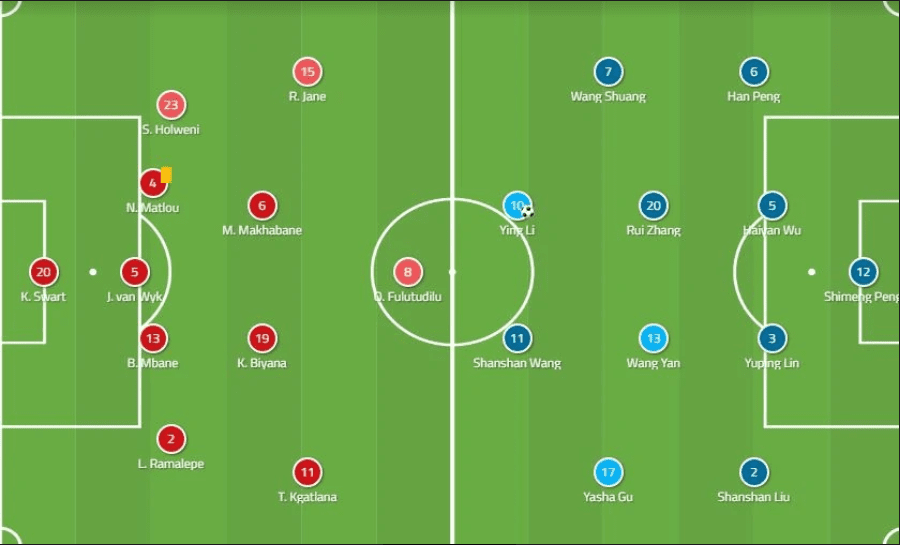
Desiree Ellis lined up South Africa in a 5-4-1. Kaylin Swart lined up in the goalkeeper position. The defensive line consisted of Lebogang Ramalepe as a right fullback, Janine van Wyk as a centre back, Bambanani Mbane as a centre back, Noko Matlou as a centre back, and Sibulele Holweni as the left fullback. The midfield line consisted of Thembi Kgatlana as a right winger, Mamello Makhabane as a right centre midfielder, Kholosa Biyana as a left centre midfielder, and Refiloe Jane as a left winger. Finally, Ode Fulutudilu lined up as the lone striker.
On the other hand, Jia Xiuquan lined up his Steel Roses in the standard 4-4-2. Shimeng Peng was the goalkeeper. The four men defensive line consisted of Liu Shanshan as a left back, Lin Yuping as a centre back, Wu Haiyan as a centre back, and Han Peng as a right back. The four-man midfield consisted of Gu Yasha as a left winger, Zhang Rui as a left centre midfielder, Yan Wang as a right central midfielder, and Wang Shuang as a right-winger. Finally, Wang Shanshan lined up as the right striker while Li Ying lined up as the left striker.
South Africa switches formation to defend Shuang and China’s wing play
One of the characteristics in South Africa’s defence was a change in formation. When defending, the Banyana Banyana switched from a 4-5-1 to 4-1-4-1. To make this change happen, the central defensive midfielder, Mbane, would come outside the back five.
In addition to this change, the midfield four and striker would all shift their position as to be closer to the defence. This converted the South African defence into a more compact 4-5-1. This defence formation was critical as it allowed South Africa to expend more players to defend China’s characteristic wing-play.
In addition to defending the wing-play, it also allowed South Africa to defend China’s most dangerous player, Wang Shuang. The Banyana Banyana knew that Shuang becomes the most dangerous in the central corridor. This is because the central corridor provides Shuang with the most space to execute her through balls and creative incision.
As such, when China were playing through the wing, Mbane would step up from the defensive line of five and start man marking Shuang. This dampened some of China’s attacks as her presence in the middle of the pitch allows the link up of the midfield, fullback, and the striker.
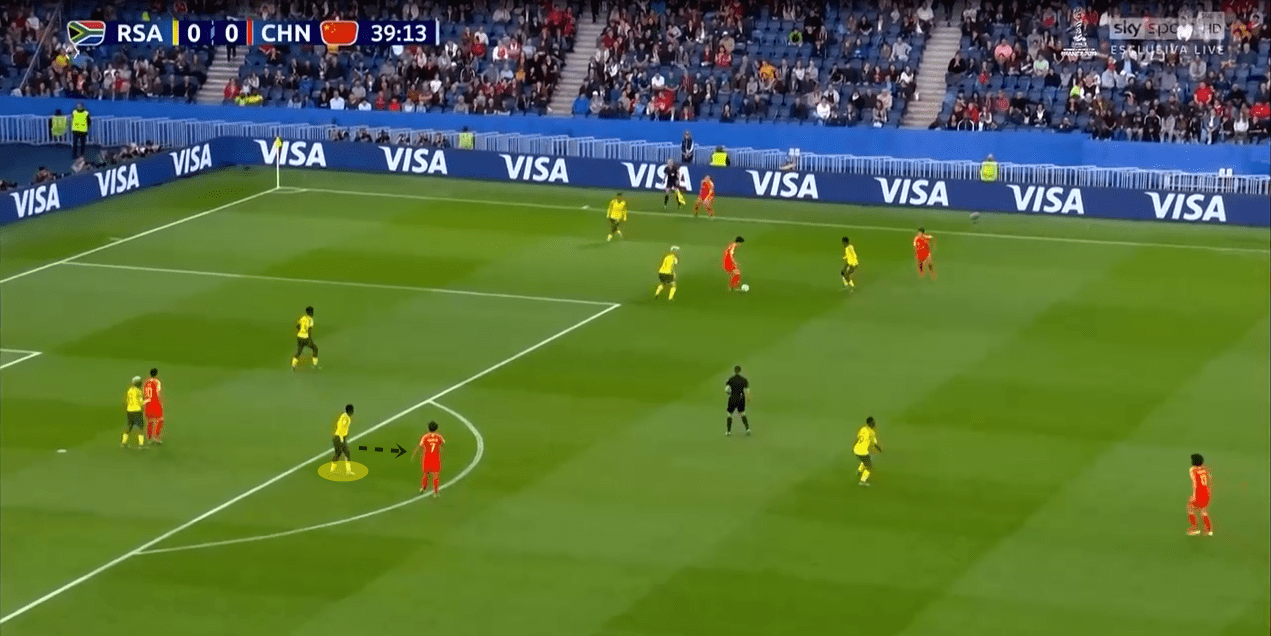
This marking, as seen in the picture above, prevents Shuang from turning or start making any diagonal runs. This is as Mbane keeps tracks of her movements in the central corridor and other spaces. As such, if Shuang were to move near the action of the play, Mbane would simply communicate to one of her teammates who would start man-marking Shuang.
This meant that Mbane could leave man-marking Shuang and start man-marking one of the forwards that were present in the central corridor.
After dampening Shuang’s effects on the pitch, South Africa took advantage of their five-man defence to defend China’s wing play combinations. China’s wing play combinations involved attacking with a winger and a fullback. This duo meant that putting one South African player to defend the wing was not going to be enough.
As such, South Africa devoted two of their defenders from their five-man backline. These two defenders would consist of a wingback and a defender. The wingback would cover and mark the opposing fullback while the defender would cover and mark the winger.
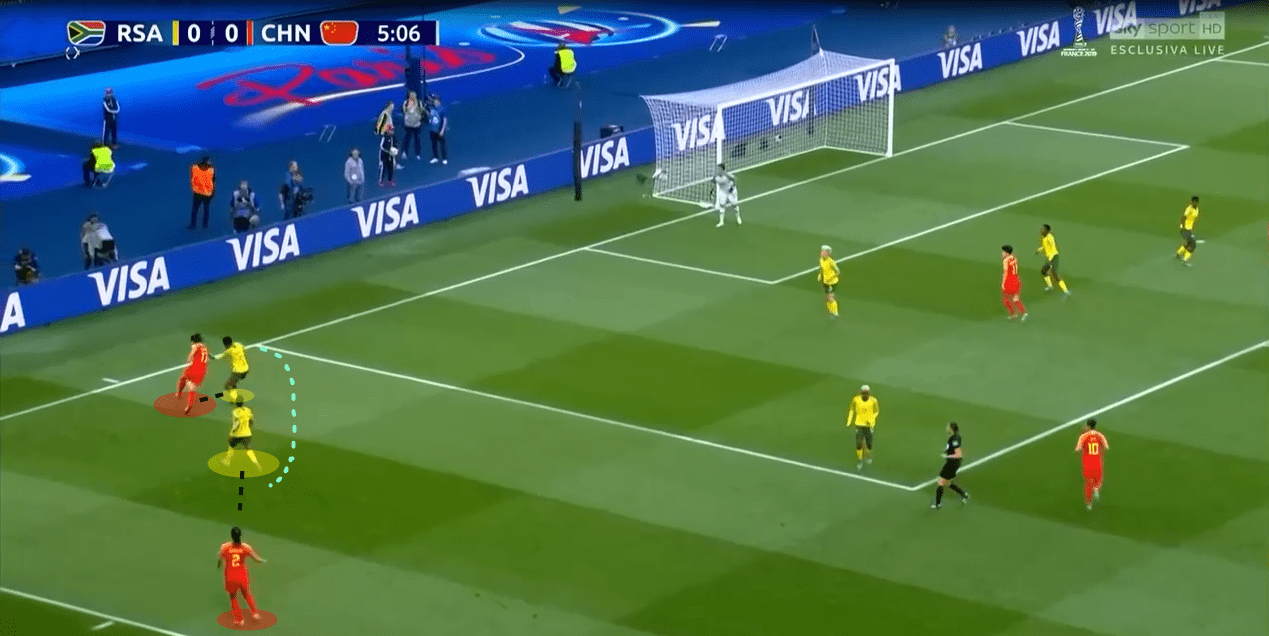
Here we see the tactic of putting two defenders against two forwards. This tactic creates a 2v2 and as such allows South Africa to contain some of the threat that would usually come against China’s wing play.
Notice how the two South African defenders are teaming up against the sole winger. This creates a 2v1 in favour of South Africa and prevents China from entering into the 18-yard box (shown in blue).
However, there is a drawback to this tactic. By sending two defenders towards the wing flank, South Africa are left with only three defenders in the middle of the pitch. Moreover, count in Mbane’s man marking of a Chinese player and South Africa were looking at two defenders to defend their box.
To counteract this, Ellis had her midfield four come closer to the defensive line and contribute to the defence. One of the ways the midfield contributed was dropping one of the midfielders in the halfspace between the wing-flank and the central corridor.
This positioning was critical as it put South African players in a space that connected the central defence against wing-play. Moreover, since the midfielder was in the halfspace, she could add numerical superiority to the wing or to the central corridor. More often than not, the midfielder would add herself to the defence in the central corridor as this ensured that South Africa would be protected against any crosses or diagonal runs.
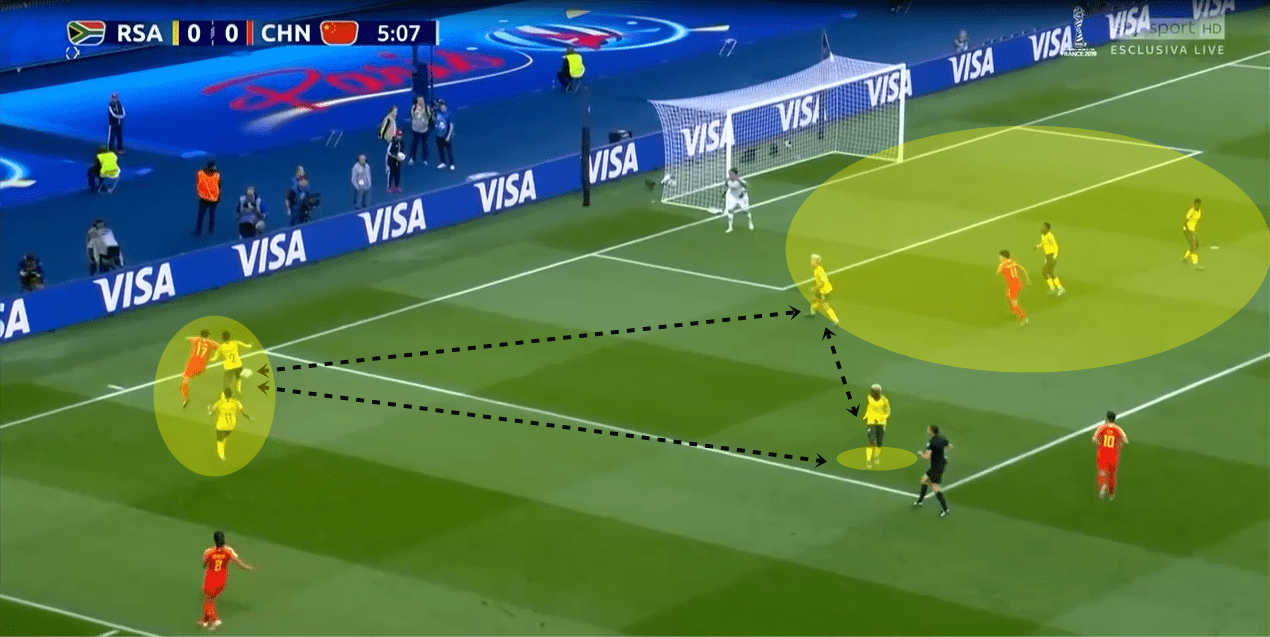
Here we see that the midfielder creates a triangle between the wing flank, central corridor, and halfspace. This triangle can be useful to keep possession of the ball, in case the Chinese player gets dispossessed.
Moreover, this triangle is also useful for switching of the positions. If desired, the midfielder can switch positions with one of the central defenders. Due to the small length of the sides of the triangle, this switch would not take up too much time.
With switches like this, a central defender can quickly occupy the halfspace and go over to the flank and aid the 2v1 situation by making it a 3v1 overload. Additionally, if the centre-back does not want to switch, the midfielder can help the 2v1 situation and make it a 3v1 situation. As such this midfielder added flexibility to South Africa’s defence.
Moreover, the midfielder could cover any Chinese player that came to support the wing play. As such, the Steel Roses would be caged which would either create dispossessions or throw-ins for either team.
If the throw-ins were taken by South Africa, it was a chance for them to regain possession. If the throw-ins were taken by China, South Africa would get a moment’s relief and properly sort out their marking. Either way, it would be a success for South Africa.
Despite its benefits, this procedure to defend the wing play of China had problems as well. To play this kind of defence, the defensive line had to be organised and structured. However, repeatedly, South Africa were fragmented and disorganised.
This lack in the structure was, in part, due to their defensive tactics. While their defensive structure was adept at dealing with isolated wing actions, it could not handle some of the complex attacking movements of China.
China would attack both wings at the same time. This made it difficult for South Africa to defence as while they were handling the wing play on one side, they also had to handle multiple runs on the opposite side.
South Africa could not commit as many players to the action on the other side of the pitch and as such, China created numerical superiority on the other side.
The other reason for the disorganised defensive structure was mainly due to the inexperience of South Africa. This tournament is their debut in the FIFA Women’s World Cup and the lack of experience was clearly seen in this match.
Repeatedly, the South African defence, due to their inexperience and communication, would let in easy passes near their goal or fail to close down certain gaps near their defence.
China look towards their buildup to attack South Africa
China’s attacking plans were rooted in the buildup. Playing in a standard 4-4-2, China’s buildup involved the centre backs splitting apart and the full backs positioning themselves higher than the centre backs.
An interesting pattern in China’s buildup involves the inclusion of a midfield pivot. This is critical to China’s attacking transition as it allows them to establish numerical superiority against any sort of pressing by South Africa.

Here we see the normal passing lanes (shown in black) that are used by China to primarily draw South Africa deeper. This aim from China is aided by the fact that South Africa is doing a man to man press (shown in purple). As such they are bound to be drawn in deeper as the Chinese players will go closer to the goalkeeper to aid in the buildup.
The interesting passing lanes are shown in red. These passing lanes connect the midfield pivot with the defence. It is important to note that as soon as one of the full backs gets possession, the respective South African player will go on to press her. When that occurs, the full backs will pass to the midfield pivot.
The midfield pivot have their body half-turned which allows for them to make one-touch passes into the space left by the pressing South African player. As such, both the midfielders can release their respective full backs into empty space. These full backs can then link up with the wingers and target an isolated full back. In a simple move, China will bypass five players from the Banyana Banyana.
However, this buildup was not made easy by South Africa. Whenever China started its positioning and ball movement to buildup, South Africa immediately started aggressively pressing each of the midfielders in the pivot.
To do this, South Africa had to switch to a 4-4-2. By doing this, each of the players were neutralized and China could not buildup as successfully. To get around this, China utilised the long ball.
To accomplish this, China would utilise either of their centre backs or the goalkeeper to provide long balls. The placement of this long ball was very important to China’s attacking plan and had to be placed near the half-way line.
This was China’s aim – to have the forwards drop deep into their own half, and a long ball to the half-way line (or near it) would mean that China could get past a huge block of South African players.
From there, the full backs and the wingers, who were already positioned high, could start their individual runs. The striker could pass it to either of the flanks and China would have their most valued attacking scenario: a 1v1 with the full back. With the likes of Shuang, these scenarios could become more dangerous.

As shown in the image above, the striker has two options. She can pass to the running full back or to the winger. Either way, China will have a resulting 1v1 or 2v1 against an isolated full back which they can exploit through crosses or cutbacks.
China looked to Shanshan to be their creative spark
While the buildup was critical to China’s attacking plans, it was only half the story. The other half of China’s attacking structure lay in when they had hold of the possession in the opposition’s half.
One of the main attacking structures for China was their use of Shanshan. Even though Shuang was positioned as a striker, she often dropped deep into the midfield. This transformed their formation from a 4-4-2 to a 4-5-1. This formation change helped China get past South Africa’s defence of their wing-play.
The inclusion of Shanshan in the midfield immediately meant that more than two or three opposition players would be attracted around her. The Steel Roses used this ability to their benefit by putting her on the wing-flank. This resulted in a dilemma for the South African defence.
Should they defend like they had defended other wing combinations? Or should they pay attention to Shanshan? Each one of the questions had their advantage and disadvantage. If they defended a wing combination from China in their normal fashion, they would leave Shanshan in the half-space, the golden space for assists.
On the other hand, if they devoted attention to Shanshan, this would mean that her attacking abilities would be dampened. However, she could just as easily, with one pass, release a pair of winger and full back. This would inevitably draw out a centre back which would mean that the central corridor could be open for a numerical superiority for China.
Shanshan could create space in the midfield as most of the South African players would be attracted to her due to her intelligent movement in midfield.
This dilemma could be seen in the lead up to the first goal for China. They started their normal wing play pattern. This pattern consisted of a midfielder carrying the ball upfield and then releasing it to a nearby winger. The winger drove inwards while the full back diverted outside.
As this was happening, Shanshan dropped in from her forward position and become available in the half space. This time, South Africa decided to pay attention by putting two players close to her.
This opened up space in the middle of the pitch and Shuang passed to one of her midfielders. From there, due to the large amounts of space and time, the midfielder made a curling cross which was met by Li Ying’s outstretched left foot. While this was the game’s only goal, it was a perfect example of China’s attacking plans.
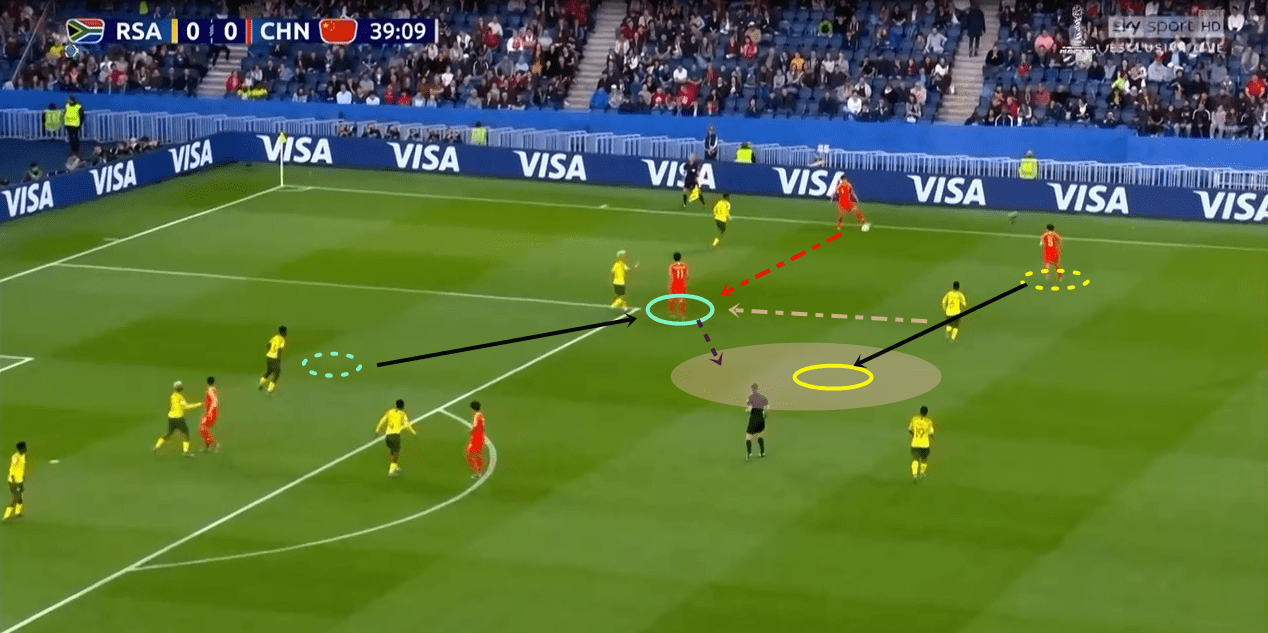
Here we see that Shanshan moved her position from the forward line to the half space (as shown in blue). From there the full back passed to her (shown in red) which had the effect of drawing another South African player to her.
At this point, Shanshan has attracted two South African players near her. At the same point, the player’s absence has resulted in a gap in South Africa’s midfield line (shown in brown). One of China’s players occupies the space (shown in yellow) and as such, is able to give the cross.
Conclusion
China will be very happy with this win. After losing out to Germany, a win was needed if they were to keep their hopes up for advancing to the next round. However, with an important upcoming game against Spain, Xiuquan will be hoping that this victory would give the Steel Roses a much-needed boost in confidence.
On the other hand, South Africa will come out of this draw feeling dejected. With their debut in the tournament being marked with two losses out of the two games played, the Banyana Banyana will be looking to play more for pride and making the most of their World Cup journey.
If you are following the FIFA Women’s World Cup 2019 then you will find our FREE tactical preview magazine the perfect compliment to the tournament. You can download it HERE – each nation is previewed and we also profile their key player and young player to watch. Enjoy!

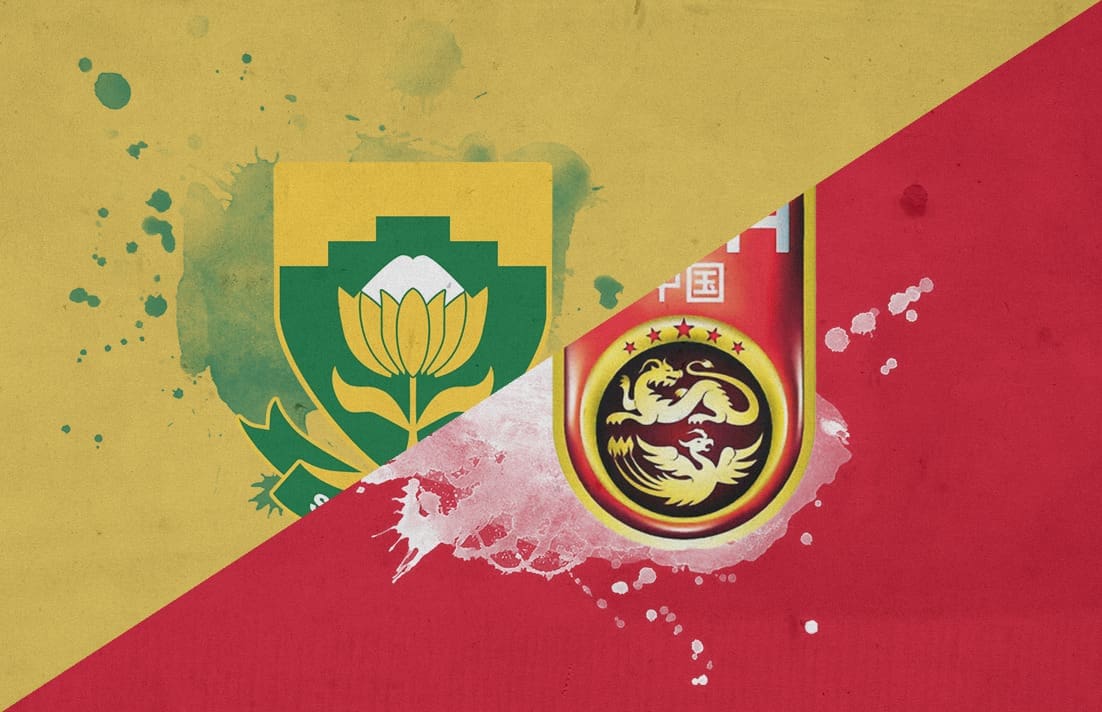



Comments